«By combining and adapting of the latest composite and laser technology, edelweiss dentistry has made a quantum leap into the future of minimally invasive dentistry. The laser process combines the best of two worlds: an homogeneous, inorganic and maximum gloss surface with a thermally tempered and dynamic composite core. Thus, an optimal integration in function and esthetics is achieved. This, combined with maximum cost-effectiveness, has convinced me and my patients.»
edelweiss VENEER
Sale price
Price
€61,20
Regular price
Unit price
/ per
Tax included.
edelweiss VENEERs are prefabricated, polymerized, radiopaque, highly filled nano-hybrid composite enamel shells with an inorganic surface.
The composite veneers make direct veneering of single or multiple anterior teeth easier than ever before. They are cemented using the same
material that they are made from, which leads to a stabile bond (between the dentin/enamel + composite + edelweiss VENEER).
edelweiss VENEERs consist of enamel shells in 4 universal upper anterior sizes (extra small, small, medium, large); and 2 universal lower anterior sizes (small, medium), that are available in one shade (Enamel VENEER – a translucent, natural shade).
Downloads
- Instruction for use
- Fact Sheet
- Brochure
- Step by Step
- Indication Guide
- Booklet_Step_by_Step
- Safety Data Sheet
Composition
- Barium dental glass
- Bis-GMA-based matrix of dental resins
- Pigments
- Additives
- Catalyst
Technical data
Filler ratio: 82 % by weight = 65 % by volume. The variation of inorganic filler particle is between 0.02-3 µm.
Indications
- Anterior and posterior restorations
- Tooth discolorations
- Anatomical deformities
- Diastema
- Erosion & Attrition
- Customized Veneers, Crowns & Bridges
- Crowns & Crown facings
- Increasing the vertical dimension (CMD)



Product Recommendation
Use left/right arrows to navigate the slideshow or swipe left/right if using a mobile device

The best for your patients
“The difference lies in the high similarity with nature.”
VENEERs from edelweiss
is state of the art for modern and minimally invasive esthetic dentistry. For the first time in the history of dental, it is now possible to work with prefabricated veneers made from nano-hybrid composite using modern laser technology. Never before has it been feasible to directly create the natural shape and youthful luminance of a tooth, so easily and perfectly in only one appointment. Its versatile area of application together with its time and cost saving procedure make edelweiss VENEERs a sound investment in the future with the best interest of the patient in mind. Convince yourself.
Transformation with edelweiss DIRECT VENEERs
The size selection
The choice of the tooth shape is performed with the available Sizing Guide (edelweiss VENEER Sizing Guide).
The Sizing Guide is positioned over the teeth to be restored, in which the visible profile allows for proper selection of the best fitting edelweiss VENEER. Adjustments can be illustrated directly on the template.

Sizes - One size for all
Based on a study of all shapes and size variations of natural tooth anatomy, prefabricated and contourable universal VENEER shapes for the upper and lower arch were developed in the following range of sizes (20 lower S/M 10 each – 30 upper S/M/L 10 each – 6 upper XS)

Sizing Guides

Small / Medium

Large / XS

Small / Medium
Shade Range

edelweiss Shade Guide
edelweiss dentin and enamel shades based on the natural layering technique.

Shade Selection
Placing the enamel VENEER shell over the dentin core.
For light refraction place glycerine within enamel shell first.
Natural Layering Technique
The concept was proposed in 1995 by Prof. Dr. D. Dietschi and was published for the first time in 1997. It is based on the idea of creating a synthesis between light, materialand color in order to mimic the natural tooth structure.
edelweiss COMPOSITE restructures teeth using two toothlike masses that are comparable to the vita dentin and enamel…

5 x Dentin
Single opacity - same hue, but different chroma levels - fluorescence. From Dentin A0, for the restoration of bleached teeth to Dentin A3.5, for cervical restorations of darker teeth for elderly patients.
Dentin Body shades exhibit high opacity and fluorescence which correspond to natural shades of dentin.
1 x Enamel
Enamel shade intensifies the translucency, which increase the true opalescence for all optical variations found in natural dentition.
Basic Tint:
Enamel
3 x Effect Shades
Effect Blue serves to enhance blue-opalescent effects of the incisal edge.
Effect Ice helps to simulate widespread enamel opacities.
Opaque White is mainly used in combination with other shades to produce “opaquers” of desired shade to cover either severely discolored tissues or metals.
Tint: Effect Blue, Effect Ice,
Opaque White
edelweiss Shade System

edelweiss VENEERs & OCCLUSIONVDs consist of the shade Enamel – Vita Enamel AO.
The respective dentin and enamel shades used to cement the VENEER will determine the final shade tone of the restoration.
Example: edelweiss VENEER (Vita Enamel Shade AO) cemented with Dentin Shade A3 (Vita Dentin Shade A3) will result in the Vita Dentin Shade A3.
VENEER on stone model - Step by Step

1. Select Size for VENEER using edelweiss Sizing Guide. Single or combined VENEER Sizes.
2. Select the Dentin Shade at Cervical Area with Shade Guide.

3. Placing the Enamel VENEER over the Dentin Core. For light refraction place glycerine within enamel shell first.
4. Sharpen the marginal edges and roughen inner surface of the edelweiss VENEER.

5. Adapt the fit and shape along the gingival margin.
6. Minimally invasive tooth preparation.

7. Trial fit visualization of edelweiss VENEERs. Facial View.
8. Apply ultra-etch (UPI) for 20 sec., then rinse and slightly dry, leaving surface slightly damp.

9. Place a puddle coat of peak univ. bond (UPI) on tooth and gently agigate for 10 sec. Blow air using half pressure to thin and remove solvents. Surface will appear shiny.
10. With VALO (UPI) Cure 10 sec. at Standard power. With over light cure for 20 sec.
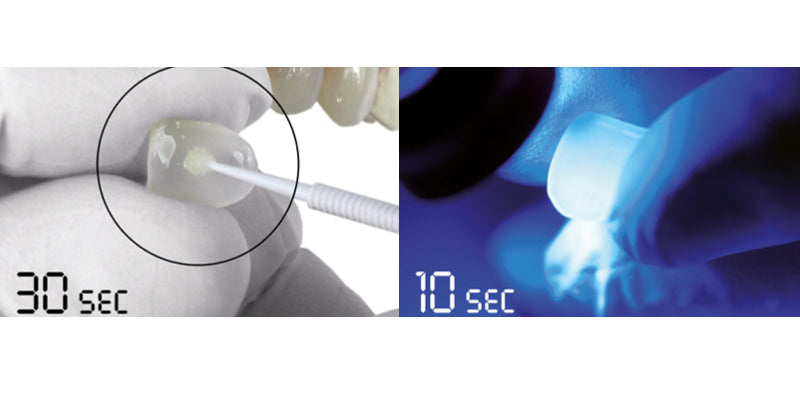
11. Apply direct VENEER BOND onto inner surface of edelweiss ENEER - 30 sec.
12. With VALO (UPI) cure for 10 sec. at Standard power. With other light cure for 20 sec.

13. Optional: Characterization using edelweiss COMPOSITE FLOW or EFFECT SHADEs. (Mamelon, dark cervical) Light cure for 20 sec.
14. Clean finger with Isopropyl Alcohol wipes.

15. Dispense 1 cm strip of NANO-HYBRID COMPOSITE onto finger tip.
16. Shape NANO-HYBRID COMPOSITE into a small, round ball.

17. Place and press NANO-HYBRID COMPOSITE into concave surface of VENEER.
18. Adapt N.-H. COMPOSITE into edelweiss VENEER. Optional: characterize using FLOWABEL ENAMEL COMPOSITE or EFFECT SHADEs, translucent on incisal area.
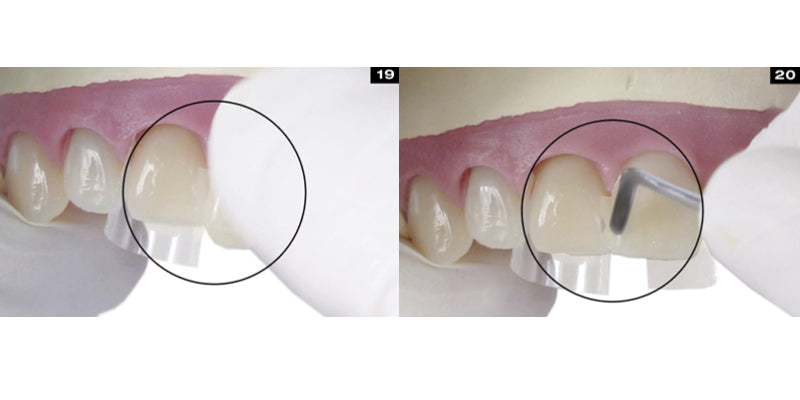
19. Position and cement edelweiss VENEER into place. Tip: Reduce surgical light.
20. Contour excess edelweiss NANO-HYBRID COMPOSITE.

21. Remove excess edelweiss NANO-HYBRID COMPOSITE.
22. After positioning light cure with VALO (UPI) palatal and facial side of edelweiss VENEER for 40 sec.
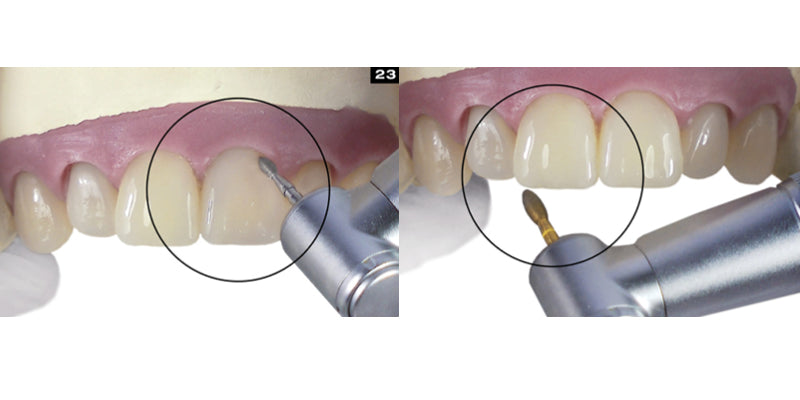
23. Finish cervical margins using fine finishing diamonds.
40 μm/8 μm
24. Finish incisal edges using fine finishing diamonds.
40 μm/8 μm

25. Finish interproximal margins using fine finishing diamond.
Diamant 40 μm/8 μm
26. Finish interproximal areas using finishing strips or soflex discs.

27. Polish interproximal areas using interproximal polishing strips or soflex discs.
28. Polish cervical areas using silicone rubber polishers (moistened).

29. Final postoperative situation.
VENEER on patients - Step by Step

1. Shade Guide.
2. Select the dentin shade at cervical area with dentin Shade Guide.

3. Placing the Enamel VENEER shell over the dentin core. (for light refraction place glycerine within enamel shell first).
4. Select edelweiss VENEER size using edelweiss Sizing Guide (single or combined VENEER sizes may be used).

5. Apply Ultra-Etch for 20 sec., then rinse and slightly dry, leaving surface slightly damp.
6. First anterior VENEER in position.

7. Place Mylar Strips both mesial and distal of all teeth to be treated.
8. Pull Mylar Strips facially to achieve smooth margins and cure through Mylar Strips for 3 sec. (VALO UPI). With other Light cure for 6 sec.

9. Light cure lingual and facial side of tooth for 20 sec. each (VALO UPI). With other light cure for 40 sec.
10. Finish cervical and interproximal margins using fine finishing diamonds.
Mechanical Properties
• Good abrasion resistance
• Very good physical and mechanical properties
• Antibacterial surface due to zinc and fluorine particles in the filler
• Easy polishing
• Natural fluorescence and opalescence
Technical Data
|
--> VENEER |
N.-H. Composite |
N.-H. Flowable Composite |
|
|---|---|---|---|
| Flexural Strength | 200 MPa | 150 MPa | 120 MPa |
| Compressive Strength | 550 MPa | 480 MPa | 350 MPa |
| Flexural Modulus | 20 GPa | 12.5 (dentin) - 16 GPa (enamel) | 68 HV |
| Surface Hardness | 100 HV | 80 HV | 68 HV |
| Polymerization Shrinkage | - | 2.50 % | N.A. |
(Source: internal data from edelweiss dentistry)
Technical Aspects
View of a sectioned extracted human molar with a cemented prefabricated composite VENEER bonded to half of the enamel surface and the other half to the dentin surface.


The most relevant observation made was obtained upon the evaluation of the inner adaptation of the restoration. No defects were visible at the interface of the enamel or in between the restorative composite and the VENEER, which confirmed the excellent bond strength and stability at both interfaces (dentin/enamel to composite, composite to edelweiss VENEER).
Repairability






Patient Cases - Before/After

Anatomical deformities

Anatomical deformities

Crown facings / Abrasion

Crown facings / Abrasion

Crown facings / Abrasion

Crown facings / Abrasion
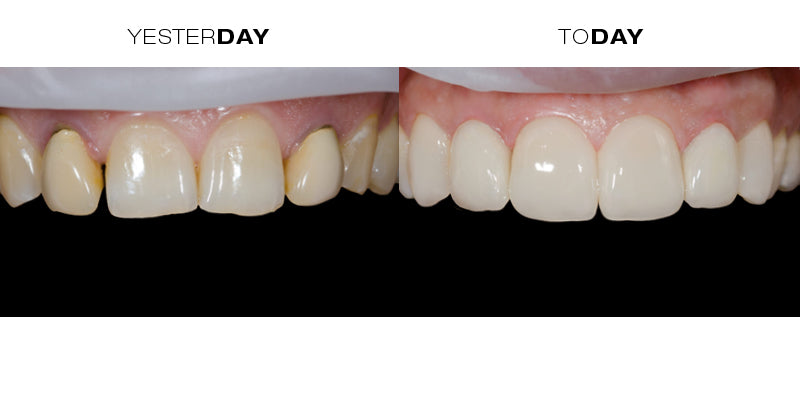
Crown facings / Abrasion

Diastema

Attrition / Abrasion

Caries / Diastema

Anatomical deformities

Veneer

Anatomical deformities

Discoloration / Devital

Misaligned teeth / Abrasion
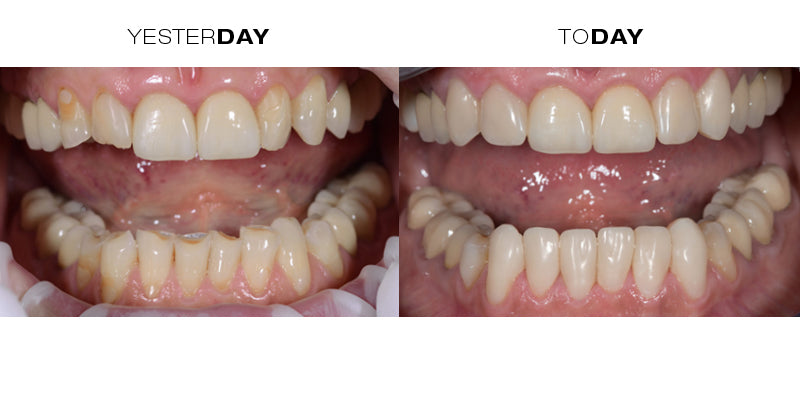
Attrition / Abrasion

Attrition / Abrasion

Fibreglass/Periodontal
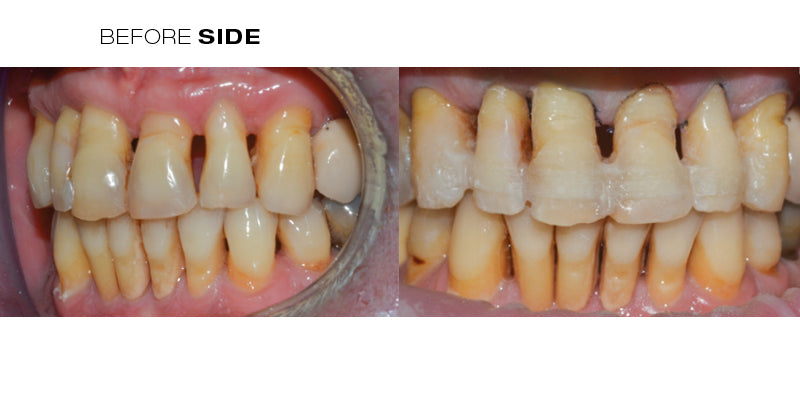
Fibreglass/Periodontal

Fibreglass/Periodontal

Fibreglass/Periodontal

Discoloured teeth





